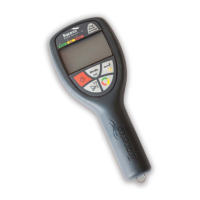11 MN1007-C
3.1.2 Scintillation Probe
The scintillation probe utilises an inorganic scintillator crystal which is very sensitive to the detection of gamma
radiation. It may also detect the higher energy beta radiation emitted by certain nuclides in the natural activity
decay chain.
A focus on gamma radiation detection sensitivity makes the scintillation probe ideal for measuring radium nuclides
and the associated decay chains. The probe has been designed to provide optimum radiation collection efficiency
without significantly reducing the ruggedness of the probe.
The nature of the design provides for near 360 degree collection of radiation thus providing an extremely effective
monitor for pipe internals.
Figure 2 - Scintillation probe
High gamma radiation sensitivity is particularly suited to detecting NORM through pipe or vessel walls where
internal monitoring is not possible and access limited to the external surfaces. In these situations the probe can be
used in an end-on configuration to directly monitor against the surface of interest.
The potential problems associated with the Geiger Müller probe - where wet or oily surface contamination of scale
limits detection of alpha and beta radiation - are largely overcome by the use of the scintillation based probe:
gamma ray emissions from scale are relatively unaffected by the presence of small quantities of oil and water.
An exception to the above is where areas of known Pb-210 deposition exist. In this case the GM probe will be
more effective.

